Sunday Morning on the Damrak
Bus tours. We probably have a similar reaction with those two words. Visions of tourists, who at least in Amsterdam, drift unknowingly into bike paths while guides leading them around the typically viewed neighborhoods. A type of tour that stands at the end of my travel list, even though I have never tried. When the option arose Saturday night at the dinner table for my boyfriend, his parents and I to take a one-day bus tour to Bruges, I thought why not. So there, in front of the Lindbergh Tours’ office on the Damrak we found ourselves the next morning, watching the expected crowd form as we waited for further instructions.
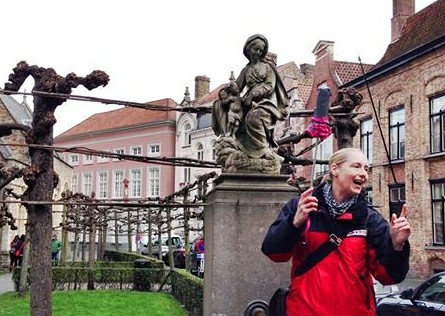
Interestingly, Lindbergh Tours hosts a variety of walking and biking tours, cruises and day-trips around the Netherlands and Belgium. With their services you can visit the markets of Amsterdam, windmill village of Zaanse Schans or medieval city of Bruges for the afternoon. Their 65 Euro ticket to Bruges costed around the same price as a round-trip train ticket, and also included a multilingual tour guide who, in English or Spanish, could talk for hours about the Netherlands and Belgium. As we headed to Bruges on the bus past Amstelveen, Utrecht, Breda, and Antwerp, I learned new facts such as the amount of dykes in the Netherlands, Utrecht’s 50,000 Euro Christmas tree, the Dutch work ethic in addition to highlights in Belgium cuisine, Bruges’s reinvention and the city’s former dominance in trade. We were not even to our destination and I already appreciated the information provided about the country I lived in and its surrounding areas.
##Swans and Waffles
We came to a stop at Brugge Bargeplein a little after lunchtime. Before filing out of the bus, we were warned of our unwavering 18:00 departure and advised to be back at the bus by 17:45. That only gave us around five hours if we did not want to take the train home. As a group, we walked over the bridge, through Minnewaterpark, and up Katelijnestraat passing Site Oud Sint-Jan and Onze Lieve Vrouwekerk (Church of Our Lady). We continued toward Markt, the main square in Bruges with such attractions as the Provinciaal Hof (Provincial Court) and Belfort (Belfry), where we stopped for a moment to hear the story about Bruges’s swans.
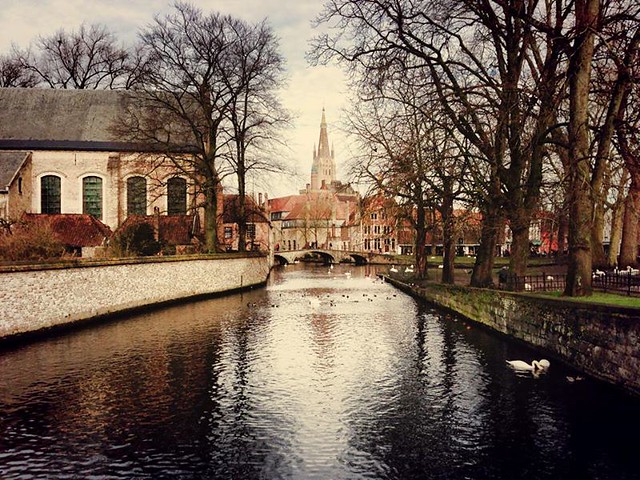
It is not something you notice at first - the swans in Bruges’s canals. They fit it with this Belgium fairy-tale set by the stone streets and antiquated buildings. However, since the 15th century, these swans have been reminding Bruges’s residents of the wrongdoing committed centuries prior. A rebellion broke out in 1488, which saw the death of Maximilian of Austria’s magistrate, Pieter Lanchals, who’s last name was very close to the word in Dutch meaning long neck. When released from prison, Maximilian ordered that swans, or birds with a long neck, to be placed in the city’s canals as a punishment. A strict order, but one that can be also enjoyed by visitors to the city.
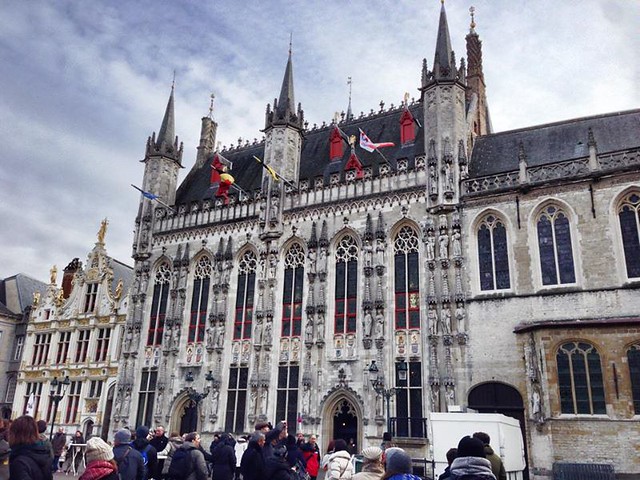
We continued our walking tour to our final destination, Burg Square, the second of two medieval squares lined with several historical buildings including Stadhuis van Brugge (Town Hall), Heilig Bloedbasiliek (Basilica of the Holy Blood), Bruges Vrije (Mansion of Bruges) and D’oude Civiele Griffie (The Old Civil Registry). At this point, my boyfriend, his parents and I needed to make a game plan for our short visit, but with the help of a typical Belgium treat. Around the corner on Breidelstraat stood Chez Albert, a recommendation by our tour guide for waffles. Two of us took the cherry-topped option, their seasonal special, while the others opted for Nutella, whipped cream or a combination of both. After waffles, coffee and our first group photo of the day, we started our own exploration of Bruges.
Dali’s Gala and Michaelageo
Whenever visiting a city, even if it is only for an afternoon, I have three things to check off: food, culture and walking. With food partially satisfied, a museum was next in order to fulfill the cultural requirement. We walked back down Breidelstraat toward the Markt to visit the Dali xpo-gallery inside the Belfort (Belfry). The set up and décor might suggest an amateur operation, however the Dali xpo-gallery’s extensive permanent collection that included drawings, watercolors, sculptures, paintings, lithographic prints, graphic arts and quotes displayed Dali’s prolific career beyond The Persistence of Memory or Crucifixion. Amongst all of these pieces, it was a lithographic suite that caught my eye.
Near the back of the gallery on the left wall stood a series under the title Les Diners de Gala. I started to think that maybe that waffle was not enough with my interest in food illustrations. In 1973, a surrealist cookbook was released under the same name, which included twelve chapters with 136 curiously titled recipes such as the Frog Pasties, Peacock a L’Impériale, Father Hans’ Sauerkraut, and Old Champagne Sorbet. The lithographic suite displayed the illustrations made by Dali for each chapter, and even though I have no idea which cookbooks you own, I am sure none have illustrations like this. His passion for cooking and other activities were highly visible in his work and through the quotes included, a fact that is not commonly communicated about the artist. If Dali caught your attention over the years and Figueres, Portlligat or Púbol, Spain, where other major Dali collection remain, do not stand on any near future itineraries, a stop by the Dali xpo-gallery could offer an extensive, yet condensed, look into his work.
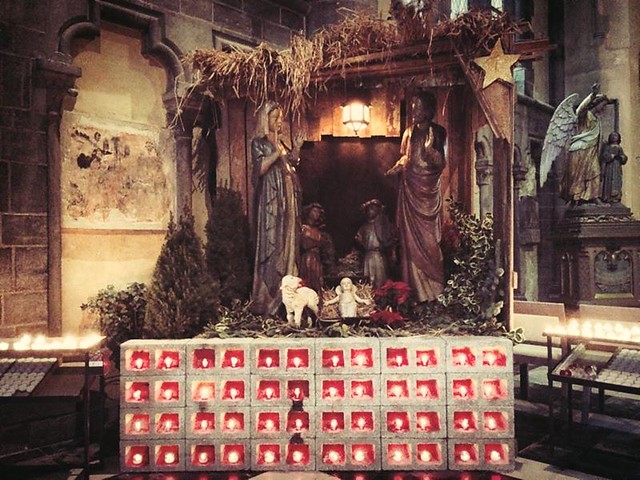
Our second cultural stop came later in the day after some casual exploration and a delayed lunch. On our walk through the winding streets back toward our original location, we visited Onze-Lieve-Vrouwekerk (Church of Our Lady), which is known for two main features. Its tower reigns as the tallest structure in the city, luckily making it very easy to find, and inside the historic Madonna of Bruges by Michelangeo sits within an elaborate alter at one end of the church. As the only sculpture by the artist to have left Italy during his lifetime, the Madonna of Bruges is highly valued by the city and only able to view through a paid entrance. Like Dali and Spain, if Italy is not next on your list, why not get a taste of Italian culture in Bruges.
Conclusion
That Sunday we woke up in Amsterdam and had waffles in Bruges. During our brief afternoon visit, we walked through the city, heard stories about its history, enjoy Belgium specialties and even experienced a bit of Spain and Italy. When we boarded the bus at 17:45, our heavy steps suggested that the three-hour ride back would be a three-hour nap. The tour guide recognized this in everyone, and allowed the group to rest instead of listen to more about either Belgium or the Netherlands. We arrive back in Amsterdam around 21:30, waking up as if from a day-long dream. The next day as my colleagues and I conversed over the weekend, I almost forgot that I went to another country with the effortless journey and quick excursion. Bus tours might still make me cringe - just a bit - however I would now consider it as a legitimate travel option, especially if it means visiting another country in ease for the day.
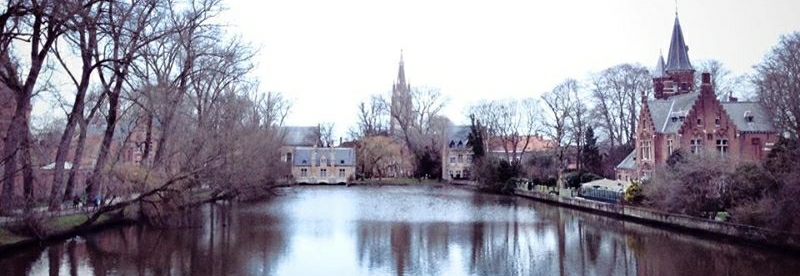
 By
By